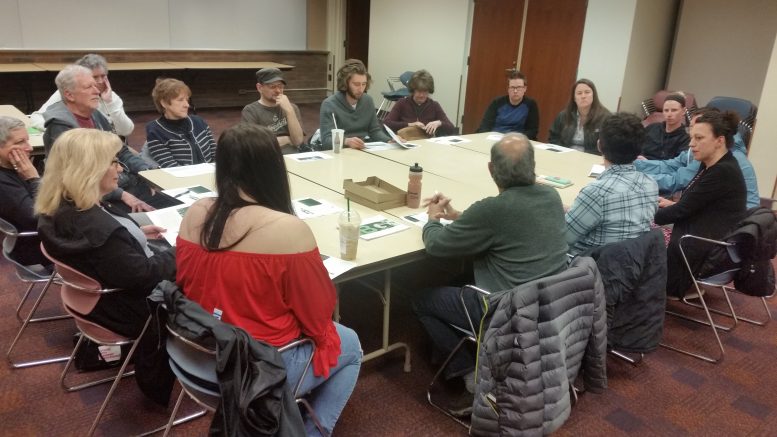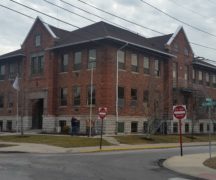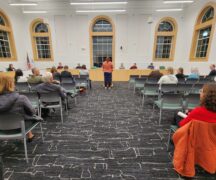By JAN LARSON McLAUGHLIN
BG Independent News
East Siders want to know exactly how the new Community Action Plan will improve their neighborhoods. How will it help stem the steady decline of housing quality? How will it make landlords better maintain their rentals?
Bowling Green City Council members Daniel Gordon and John Zanfardino held a meeting Tuesday evening for their constituents in Wards 1 and 2. The wards are on city’s East Side, which is the primary target of the new Community Action Plan.
Many of the residents want to make the most of the plan – not settle for the easiest goals to achieve.
Rose Hess objected to some city officials suggesting that the “low hanging fruit” of the very detailed plan be tackled first. She wanted that terminology banned from further discussions.
“Let’s go for the high ones,” Hess said.
Gordon agreed. “Let’s go as bold as we possibly can.”
Those high hanging fruits include rental property certifications, help for homeowners sprucing up their East Side homes, efforts to make the East Side more appealing to families, and plans to make East Wooster more attractive to people entering town.
The residents were curious about the proposed rental registration program. The landlord “self-certification” program falls short of rental inspections that some East Siders have sought for years. Both Gordon and Zanfardino said the self-certification process does not go as far as some residents had hoped.
“Self-reporting is different than being inspected,” Zanfardino said.
September Killy-Knight said the inspections are a matter of safety for renters. And John Roberts said the rental evaluations should not be voluntary.
But both Gordon and Zanfardino also know the uphill battle the city has fought and lost in previous attempts to implement some type of rental inspection program.
Gordon recalled efforts to license rentals in 1987, when his father was on City Council.
Zanfardino said similar attempts were made again about 10 years ago.
“Contentious doesn’t really capture it,” he said of opposition from landlords in the city.
Though it may not be exactly what some residents want, the rental checklist may have a chance of moving forward, Zanfardino said.
“To be honest, I think this has a real good shot,” he said. “I’m hoping the city makes a very comprehensive checklist that has some teeth.”
Though the proposal calls for the self-evaluations of rentals to be voluntary, the teeth could rest in the fact that those properties may be listed on a website among others that have gone through the city checklist.
Bowling Green State University currently has a website that lists rental properties, with information on the conditions of the units. But some East Siders suggested that the information on rentals go further – perhaps being posted on a central website and linked to other websites such as the Convention and Visitors Bureau, Downtown BG, and the Chamber of Commerce.
“Hit them where it hurts,” said BGSU student Ross Martin.
Others suggested going one step further and exposing poor rental housing on social media. Taylor Harrison talked about the idea of photos being posted, with renters being asked to respond to “Does your apartment look like shit?”
Some East Siders wanted specifics on how the CAP intended to help homeowners struggling to keep up their houses in declining neighborhoods.
“How will it improve the housing stock so people want to live there,” Julie Broadwell asked. If help isn’t available, she worried that “entire blocks are going to flip” into rentals.
Gordon and Zanfardino said the plan calls for a Community Development Corporation, which may assist homeowners, and rehab projects through Habitat for Humanity. Both council members said more provisions may be needed to help East Side homeowners.
Martin questioned the portion of the plan encouraging more family homes in heavy student sections of Ward 2. He worries that some streets are no longer suitable for families. “Why are people raising kids here,” Martin said he has wondered about his neighborhood. “There are broken beer bottles on the ground every Sunday.”
Zanfardino agreed that it will be difficult for some areas of the East Side to be reclaimed by homeowners rather than as rentals.
Killy-Knight suggested that mixed housing is needed to meet the needs of families, graduate students and undergrads.
The CAP seems to suggest that as investments are made in neighborhoods, more homeowners will be encouraged to make improvements, and students will be more likely to care about their community.
“You’re less likely to engage in nuisance behaviors if you’re invested in your neighborhood,” Gordon said.
The “big challenge” is the 70-30 split of rental to owner-occupied homes on the East Side, Hess said. She would like to see that trend squelched before it creeps up to 80-20.
But new Second Ward homeowner Jordan Cravens said that split is only natural given the growth at BGSU and stagnant population of the city as a whole. While some young professionals can’t find suitable homes in the city, Cravens said she and her partner kept looking till they found a “gem in the rough.”
David Pfleger said the city is losing other young professionals by not having better options. “There isn’t good housing stock,” he said.
The city is also suffering by not having better code enforcement, Pfleger said. The city currently has just one code enforcement officer, but plans are in place to add another.
The East Siders also talked about the CAP’s proposals to create more developments like the Market Square site at the corner of East Wooster and North Prospect streets. The coupling of retail and rental makes such projects more viable for developers, Zanfardino said.
Those type of projects could help make East Wooster Street more attractive – which is currently a big problem, Gary Hess said.
“There’s not much in there that’s very attractive,” he said.
Once those projects start on East Wooster, “good things will follow,” Hess said.
Such mixed used projects would also help “connect the corridor” between the campus and downtown, Killy-Knight said.





